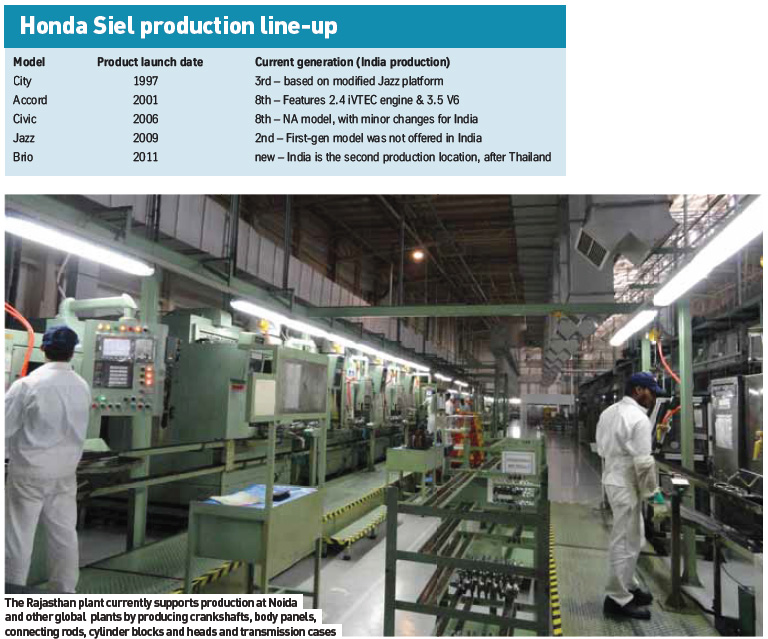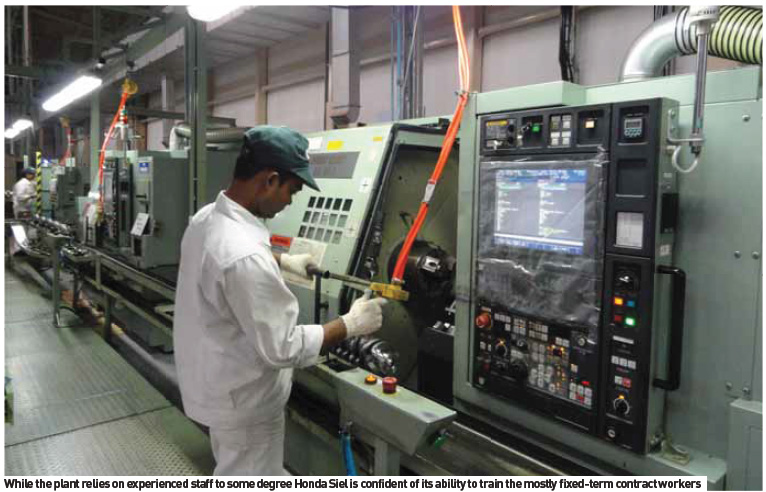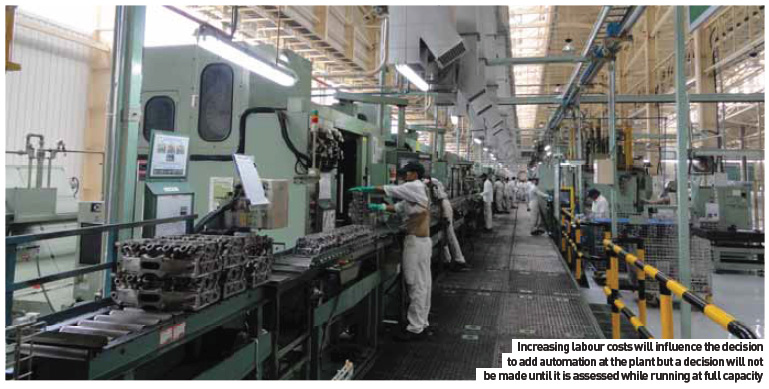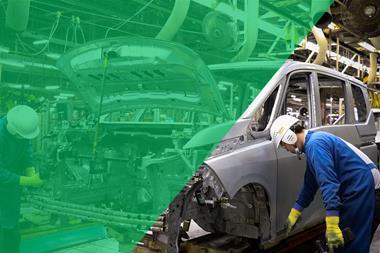
A series of global events have left Honda’s second manufacturing facility in India producing a limited number of body and engine parts. Julian Buckley travelled to the site to ask when it will get the go-ahead to start full production.
Honda Siel Cars India (HSCI) is the automotive joint venture between Honda Motor Company and Siel Ltd, the latter part of the Siddharth Shiram group, which was established in 1995. In addition to this, Honda also operates a power products (generators, etc.) joint venture with Siel in a separate partnership which has existed since 1985. With regards to automotive operations, Siel is reported to hold approximately 3% of the joint-venture, which started vehicle production in 1997.
 As of 2012, HSCI operates one full assembly plant in Greater Noida, Uttar Pradesh, located to the south-east of New Delhi. The plant produces a range of vehicles, including the City, Accord, Civic, Jazz (Fit in some markets) and the new Brio city car, which was launched in India in September 2011 (see box on opposite page for more details). The CR-V SUV is imported from Japan, with only a few changes made before vehicles are distributed around the country. Up until 2008, HSCI had enjoyed great success in the Indian market, which prompted the move to add a second car plant, located in Bhiwadi, Rajasthan, approximately 100km south of Delhi. According to Rajeev Wasan, senior vicepresident of manufacturing, the site was selected due to the availability of such a large plot of land, the relative proximity to the Greater Noida facility and the established supplier network – both Maruti Suzuki and Hyundai have plants in close proximity. Construction of the new facility was well advanced when the project was brought to a sudden standstill. “The plan to build cars here was postponed due to the global financial crisis,” states Wasan.
As of 2012, HSCI operates one full assembly plant in Greater Noida, Uttar Pradesh, located to the south-east of New Delhi. The plant produces a range of vehicles, including the City, Accord, Civic, Jazz (Fit in some markets) and the new Brio city car, which was launched in India in September 2011 (see box on opposite page for more details). The CR-V SUV is imported from Japan, with only a few changes made before vehicles are distributed around the country. Up until 2008, HSCI had enjoyed great success in the Indian market, which prompted the move to add a second car plant, located in Bhiwadi, Rajasthan, approximately 100km south of Delhi. According to Rajeev Wasan, senior vicepresident of manufacturing, the site was selected due to the availability of such a large plot of land, the relative proximity to the Greater Noida facility and the established supplier network – both Maruti Suzuki and Hyundai have plants in close proximity. Construction of the new facility was well advanced when the project was brought to a sudden standstill. “The plan to build cars here was postponed due to the global financial crisis,” states Wasan.
Although the market in India has now returned to precrash levels, the Japanese tsunami and earthquake disaster and later the flooding in Thailand have meant that the Rajasthan complex largely remains a collection of empty factory buildings. Manufacturing activity on the site is limited to supporting production at Noida and other global plants. “Here, we [currently] make body panels, and crankshafts, connecting rods and cylinder blocks and heads and transmission cases,” says Wasan. “We also take some parts out of Japan, such as crankshafts and some forgings and finish them here.” He adds that the facility has just started low- and high-pressure diecasting operations which deliver gearbox and transmission casings. The brand new four-bed tandem press, delivered by Hitachi, currently produces a range of 15 outer or “skin” panels using steel delivered by Tata Steel and Bhushan; Wasan explains that chassis components are delivered by various tier suppliers and at full production both the press and the machining lines operate over a two-shift system.
Saved from the flood
As it is, though, the effects of the natural disasters of 2011 still linger. “We went into very low production because of whathappened in Japan, and then we were affected by the [Thai] floods. Production was very low and in some cases it stopped, but this plant is still supplying parts to other regions and we’ve been able to source parts from other suppliers.”
Wasan highlights how the flooding has had a direct impact on operations at HSCI, noting that the close proximity of various Honda facilities in the ASEAN region meant that many were affected by the disaster, which had a serious impact on part quantities delivered from that area. “We couldn’t source suspension and subframe parts, so that either stopped or postponed production,” he explains. In the UK, for example, production was cut by 50% – was it the same in India? “It was much higher here,” he replies. “The plant in Thailand was under two or three metres of water for quite some time. It’s receded now, but it’s not completely cleared out. It will take several months before the plant is operational again.” According to reports released by Honda, most of the equipment at the affected facility in Thailand will have to be replaced, but at least some of the machinery has been saved from scrap. “One of our machining lines was brought here from Thailand before the flood. It’s the complete line, we were very lucky to move it when we did,” says Wasan. “It’s a second-hand line, but it’s still working. I say that every machine has a life. Some were drowned, but this one is still alive.”

New engines, new line?
Very much like the Toyota plant in Blue Springs, Mississippi, which was mothballed for three years before production started there in late 2011, Honda Rajasthan is a plant waiting for its moment. Asked if there is any timeframe in place that will see cars start rolling off an assembly line at the plant, Wasan only states that it will happen and that the plant will be one of the most integrated Honda facilities in the world. This would likely mean the start of full engine production at the plant, an activity which until now has been carried out exclusively at the Noida location. In addition to petrol engines, would this include production of the 1.6 diesel launched at the 2011 Tokyo motor show? “That engine is meant for Europe, but Honda is developing other diesel engines now,” says Wasan. “Where these are produced and what we will do with them, I can’t say at this time.” In addition to increased part stock, Honda Siel could benefit from the addition of the new engine in India. As Wasan points out, the fuel policy of the national government is currently skewed in favour of diesel, which has increased demand for models featuring these engines. In fact, he says that almost 50% of the new car market in India is made up of diesel-powered cars (excluding A-category compact models).
Assuming that Honda would look to produce such an engine in India in order to win a slice of the diesel market, Wasan says it would require an all-new production line as the existing equipment does not have the flexibility to accommodate production of the related parts. “Everything is different, the pitch of the machines and other elements. When we moved the line from Thailand, there was nothing new coming up in the portfolio so there was no problem installing it here,” he says. “I don’t think we can revise this line to build new products, I don’t think it’s possible.” Ultimately, should the new diesel engine be launched into the India market, the choice will be to install a new production line or import the engines from another region, both of which would demand capital investment. But given that hybrid engine technology is unlikely to prove popular in such a price-sensitive market, as parts brought in from Japan are subject to a punitive exchange rate, it’s a choice that must be made should Honda look to become a player in the lucrative diesel passenger car market.

Changing tactics
The tandem press line at Honda Rajasthan uses automation to move workpieces between individual stamping operations. The finished parts, though, are picked and racked by hand. Likewise in the machine shop, some processes are completed automatically while others require human intervention. Wasan explains the decision to automate: “We have some machines where parts are picked by machines, but with some machines it is still cheaper to have people move the parts. We decide based on cost what is the best solution for us.”
He admits that increasing labour costs will influence the decision to add automation, although it’s a case of waiting until the plant is running at full capacity in order to understand which processes can benefit from the additional investment. “We have a price-point, a number. Based on this we will do the math and make a decision.”
plant is running at full capacity in order to understand which processes can benefit from the additional investment. “We have a price-point, a number. Based on this we will do the math and make a decision.”
With regards to manpower, Wasan says that the area surrounding the plant – and India as a whole – offers a good mix of skilled and unskilled labour. Of the approximately 500 people currently employed across the site, he estimates that up to 30% are full-time staff, including engineers, while the remainder are hourly workers who are trained as necessary. “It is our responsibility to train these people as the industrial training in this country is not so good.” India is currently a market in flux. From month to month, dramatic market swings can require immediate adjustments to production output. To address the increasingly fluid local market, the carmaker employs fixed-term rather than temporary workers, says Wasan: “This allows us to retain some flexibility, we can’t have everybody as a permanent staff member.” According to Wasan, fixed-term employees are trained on specific processes and equipment. Some go on to be offered full-time employment at Honda, while others leave to work in other industries.

Despite periods of reduced production caused by the financial crisis and last year’s natural disasters, Honda Siel maintained the carmaker’s global policy of no enforced redundancies. “If a [fixed-term] contract ended, maybe it wouldn’t be renewed, but no permanent people were asked to leave.” Wasan goes on to say that when the lines were not running, some people were simply allowed to go home, still on full pay. “We didn’t adjust salary, it’s not their fault,” he says. “The market will come back and we want to have the people to support full production.”
A portion of the 500 people working at the plant are from a third-party logistics provider that packs and ships finished parts to other facilities around the world. Any unnecessary churn could impact part quality, but Wasan says that he has full confidence in his people to maintain the stringent quality levels for which Honda is well known: “This is a future plant. As such, we have put in a system where we’re not inferior to any plant anywhere. There is still demand for export parts, but I don’t worry about part quality. I just ask how much they want and I can send it.”
He further says that skilled employees, particularly those that maintain the machining equipment, are sometimes poached by other companies. Does he return the compliment and look to other companies to fill vacancies? “We do not,” is the curt reply. “We rely on our system of training at the plant. Of course, you need some people that have experience and when the lines are running you need to be able to maintain the manpower. But we don’t always look for experience, we can train people as required.”
“We can take people from any region in the country, there’s no restriction that says we have to take people from the local region. But when we move into an area, we have to live with those people, so we do prefer to work with local labour, create jobs. When we’re looking for a particular person, we’ll look locally first and then to the remainder of the country.”
Future plans
The buildings and other infrastructure elements are in place, but weld, paint and assembly equipment will have to be purchased and installed before finished vehicles can roll out of Honda Rajasthan. Although he has been involved with manufacturing for the past 14 years, Rajeev Wasan spent the 17 years prior to that in purchasing and as such he has a wealth of associated experience, but does Honda head office dictate which suppliers must be used to equip the plant? “The decision to use any given supplier is based on cost, quality and how they shape up. Honda is a conservative company, we’re not going to do anything new here; we would probably have the same paintshop supplier, for example. But it’s a changing world and we’ll have to look a little more closely at who is competitive.”
Over the series of annual AMS India conferences, senior manufacturing executives from India’s OEMs have regularly complained that some equipment suppliers do not offer the required level of support to in-country carmakers. Wasan says that such issues are not a major concern: “We simply have to make sure that the product quality is world-class. We will do whatever we need to do to achieve that, while making sure the cost is competitive. Everything depends on that.” When asked about his first priority at the Rajasthan plant, Wasan answers without hesitation. “I want to start building cars at this plant. It’s what we’re here for, that’s the priority. Once we have realized that goal, we will look to incorporate a little more automation, that will be the second step.” Once given the green light, he believes that it will be about two years before the facility can expect to produce its first car. With all that has happened to Honda Siel over the last few years, that can’t come soon enough for Rajeev Wasan.




































